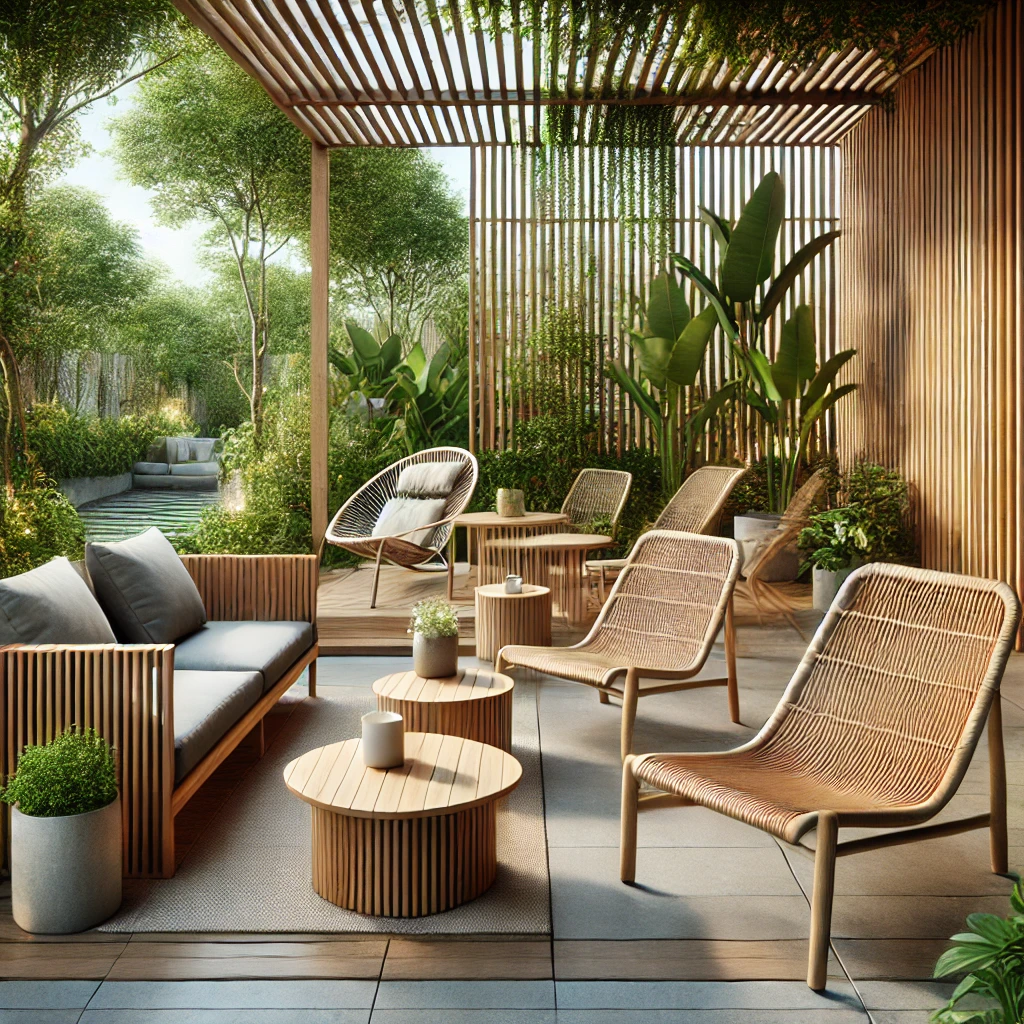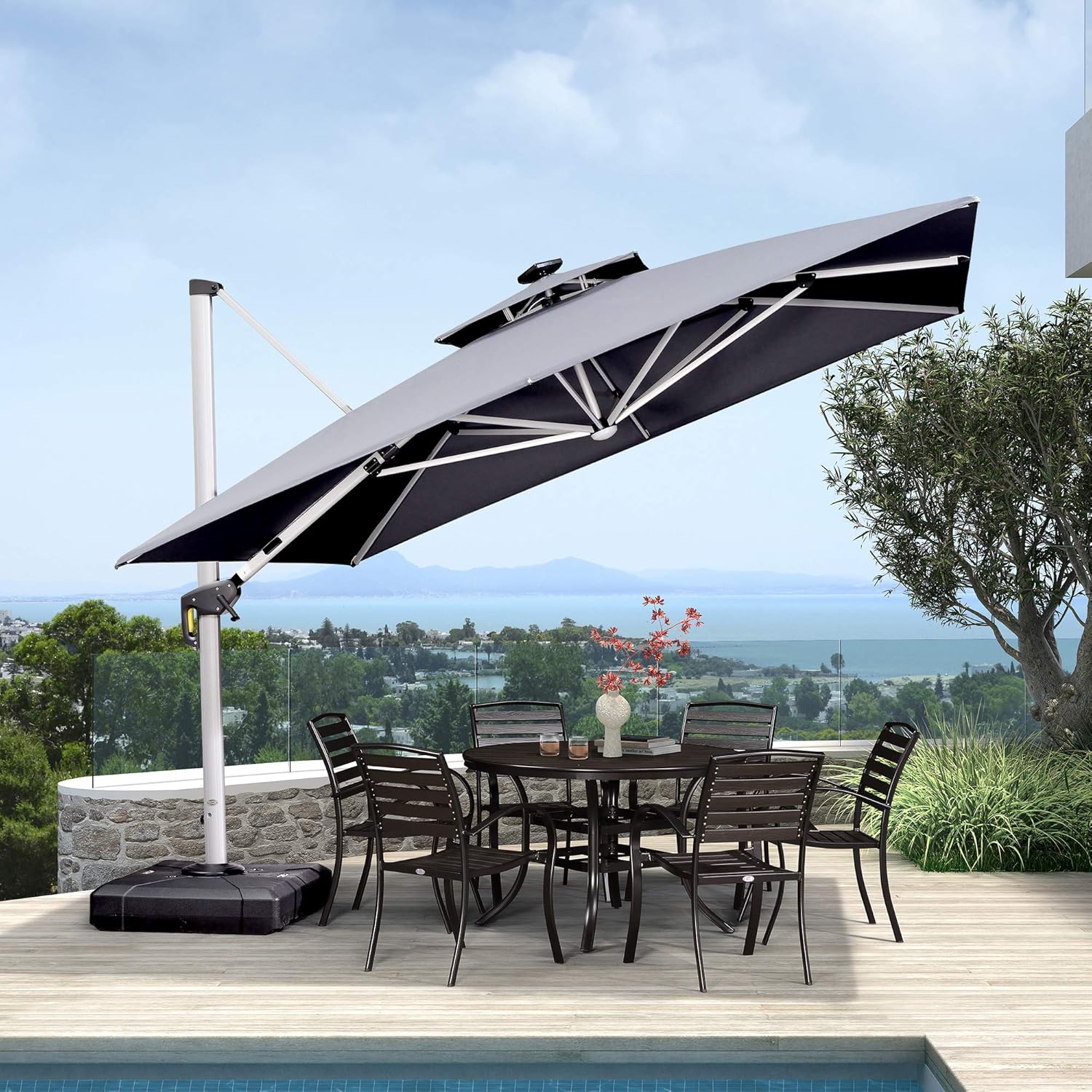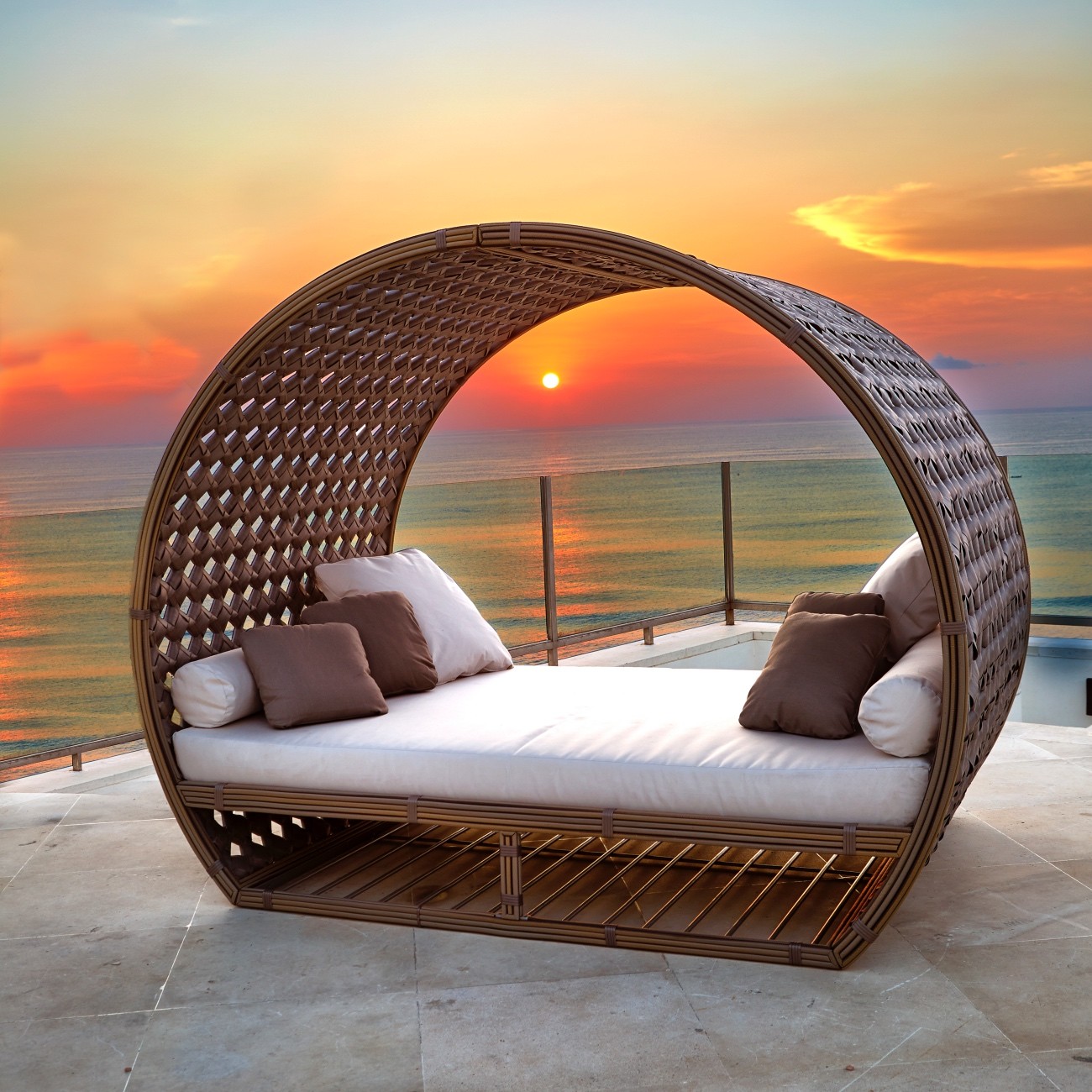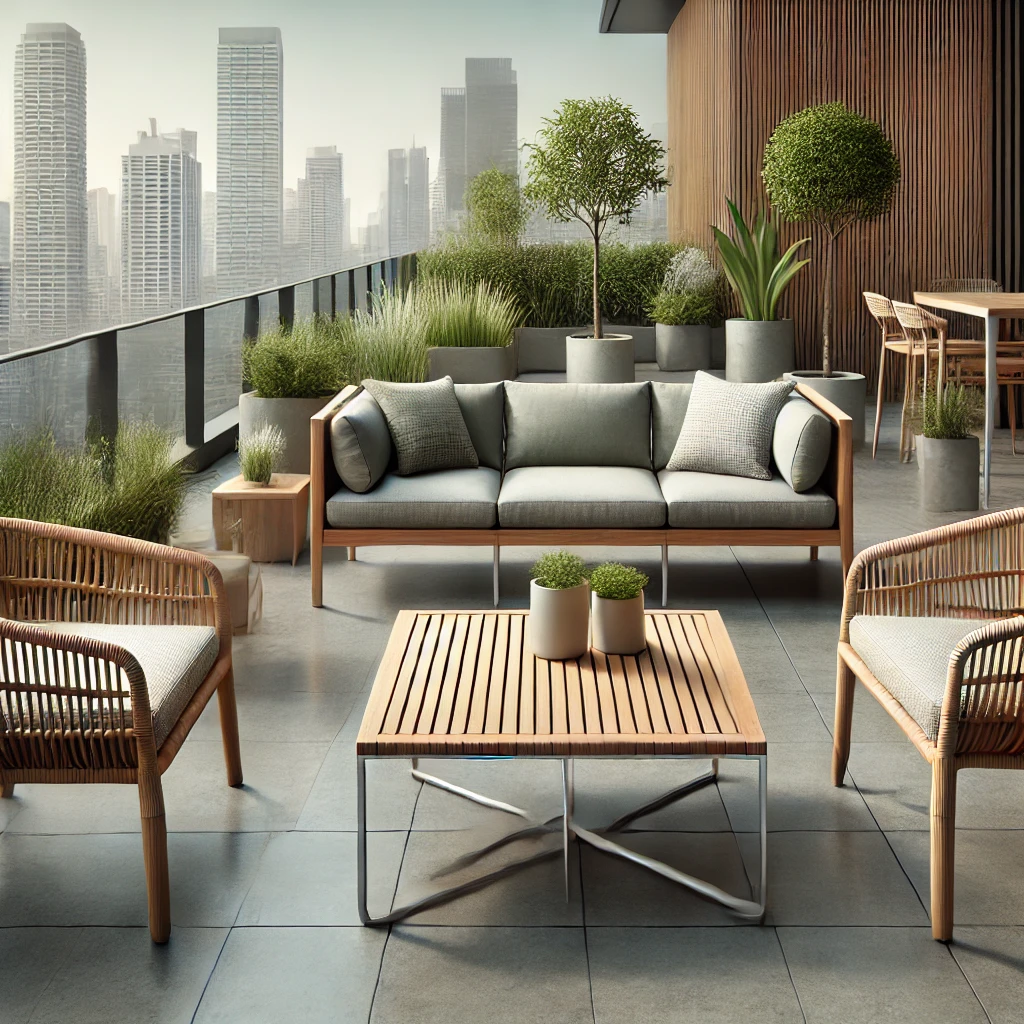In today's green trend, environmental protection is no longer just a fashionable word, but a lifestyle choice. And this choice can be reflected from the small patio furniture. Maybe you have already equipped yourself with a beautiful patio, placed comfortable chairs, tables, or even a luxurious hammock.
So, what is eco-friendly patio furniture? Simply put, it is furniture made of sustainable materials and environmentally friendly processes. These furniture not only reduce the negative impact on the environment during the production process, but also can be effectively recycled or degraded after the end of its service life, reducing harm to the ecosystem. Choosing eco-friendly patio furniture is not only a fashion trend, but also a life attitude, expressing respect for the environment and a sense of responsibility for the future.
Let's take a deep look at eco-friendly patio furniture, from its materials to how to choose, to its quality and style. We will take you into a patio world full of natural breath, comfort and responsibility.

What Are the Materials of Eco-friendly Patio Furniture?
When it comes to eco-friendly patio furniture, the first thing to discuss is their materials. These materials are not only durable and beautiful, but more importantly, they are environmentally friendly. So, which materials can be called "environmentally friendly"?
Teak: A Sustainable Classic Choice
Among eco-friendly patio furniture, teak is undoubtedly one of the most popular choices. Why? First of all, teak is extremely durable and can maintain its service life for decades even in harsh outdoor environments. Secondly, teak is rich in natural oils, which makes it excellent in waterproofing, insect resistance and anti-corrosion, and almost no additional chemical treatment is required.
In addition, real eco-friendly teak furniture comes from sustainably managed forests, that is, those certified plantations, ensuring that every tree cut down has enough replanting. This not only helps to protect forest resources, but also effectively reduces the negative impact of the wood supply chain on the environment.
Recycled plastic: a creative way to turn waste into treasure
Recycled plastic is also one of the popular materials for making eco-friendly patio furniture. These plastics usually come from waste plastic bottles, bags or other waste plastic products, which are processed and reused into furniture materials. The benefit of recycled plastic is that it not only reduces the pollution of waste plastic to the environment, but also creates beautiful, durable and easy-to-maintain patio furniture through modern design and technology.
It is worth mentioning that recycled plastic furniture is usually resistant to various harsh weather conditions and will not be attacked by moisture, mold or insects like wood. This makes them particularly suitable for outdoor use, both beautiful and environmentally friendly.
Aluminum alloy: light and renewable
Aluminum alloy is also an environmentally friendly material for patio furniture, especially suitable for modern style designs. Aluminum is not only light and durable, but also has strong corrosion resistance, which makes it very suitable for outdoor environments. What's more, aluminum is a material that can be recycled infinitely and will not degrade due to multiple recycling.
When making aluminum patio furniture, manufacturers usually use some or all recycled aluminum, which not only reduces the demand for virgin aluminum mining, but also reduces energy consumption and carbon emissions in the production process.
Bamboo: a fast-growing and environmentally friendly choice
Bamboo is a fast-growing and very environmentally friendly material. It is a renewable resource with a short growth cycle, usually matures within 3 to 5 years. In contrast, hardwood may take decades to mature. The sturdiness and durability of bamboo also make it an ideal material for making patio furniture.
In addition, bamboo also has extremely strong compressive and bending strength, which makes it perform well in outdoor furniture. Through modern processing technology, bamboo can be made into a variety of shapes and styles to meet different design needs.
Wicker: A Popular Choice for Patio Furniture
Wicker furniture has a long history in the field of outdoor furniture, and modern environmentally friendly wicker furniture is mostly made of synthetic fibers. This fiber is usually made of recycled plastic or natural materials, which not only retains the woven beauty of traditional wicker, but also has better weather resistance and environmental protection.

What Should I Pay Attention to When Buying Patio Furniture Made of Environmentally Friendly Materials?
First, check whether the furniture has been certified. For wood furniture, FSC (Forest Stewardship Council) certification is an important symbol, indicating that the wood comes from sustainably managed forests. Other similar environmental certifications include Rainforest Alliance certification, Greenguard certification, etc., which can be used as a reference for you to judge the environmental protection of furniture.
Secondly, understanding the source of furniture materials is also a key step. Ask the manufacturer or salesperson of the furniture to find out how the materials are collected, whether they are sustainably managed, and whether recycled materials are used. This will not only help to judge the environmental protection of furniture, but also allow you to better understand the characteristics of these materials, so as to better maintain and care for your furniture.
In addition to the materials themselves, the production process of furniture should also meet environmental standards. This includes whether harmful chemicals are used in the manufacturing process, whether production waste is effectively handled, and whether the production factory follows environmental regulations. If possible, choose brands and manufacturers that take environmentally friendly measures during production.
Finally, consider the lifespan and recyclability of the furniture. Eco-friendly furniture should not only reduce the impact on the environment during use, but also be recyclable at the end of its life cycle. Choose furniture with strong structure and durable materials, while ensuring that these materials can be recycled or reused after scrapping, so as to truly achieve sustainable development.
Which Eco-friendly Patio Furniture has the Best Quality and Durability?
Among the many eco-friendly materials, which patio furniture has the best quality and durability? The answer may vary from person to person, as different materials perform differently in different environments, but the following materials are generally considered to be the most high-quality and durable.
Teak furniture
Teak is undoubtedly the leader in quality and durability. Its natural oils make it extremely resistant to weathering and corrosion, and it can remain in good condition for decades even without the use of protective coatings. The sturdiness and stability of teak furniture make it ideal for long-term use, and its natural golden hue can gradually oxidize to an elegant silver-grey over time, which changes its beauty.
Recycled plastic furniture
The durability of recycled plastic furniture should not be ignored either. Although it has a different texture than wood, it performs very well in bad weather. Whether it is heavy rain, strong winds or sun exposure, recycled plastic furniture can withstand these natural erosions well and does not require special maintenance. In addition, it is highly resistant to stains and easy to clean, which is perfect for those who don't want to spend too much time taking care of patio furniture.
Aluminum Furniture
Aluminum furniture is known for its lightness and durability. Compared with wood or plastic, aluminum alloy has stronger corrosion and oxidation resistance, especially in humid or seaside environments. Aluminum furniture is usually simple and modern in design, which is perfect for modern style patios or courtyards. And because aluminum is highly recyclable, using aluminum furniture also helps reduce the consumption of natural resources.
Bamboo Furniture
Although bamboo is lightweight, its sturdiness and durability should not be underestimated. Bamboo furniture performs very well in outdoor environments, especially in areas with mild climates. Bamboo's natural insect resistance makes it less susceptible to insects, and its fast-growing characteristics ensure that it is a sustainable material. If properly treated, bamboo furniture can be as durable as wooden furniture.

What Styles Are There for Eco-friendly Patio Furniture?
The popularity of eco-friendly furniture doesn't mean you have to sacrifice style. On the contrary, many eco-friendly furniture brands are committed to combining eco-friendly materials with modern design, providing a variety of style options. Whether your patio is modern, traditional, rustic or bohemian, you can find suitable eco-friendly patio furniture.
Modern style
Modern-style eco-friendly furniture is usually based on simple lines and neutral tones, and common materials include aluminum alloy, recycled plastic and bamboo. These materials are not only durable and environmentally friendly, but also show a fashionable and avant-garde visual effect through design. Whether it is a chair with an aluminum alloy frame or a table made of recycled plastic, these modern-style furniture can bring a simple yet textured decorative effect to your patio.
Country style
If you like a warm and natural atmosphere, country-style eco-friendly furniture may be your best choice. Teak and bamboo are the most commonly used materials. They have warm natural tones and can
easily blend into the natural environment outdoors. Through simple and textured designs, these furniture can add a leisurely and comfortable feeling to your patio.
Bohemian style
Bohemian-style eco-friendly furniture is known for its free and casual design. You can choose bamboo or recycled plastic furniture with bright colors and rich patterns. These furniture are often exotic and perfect for families who pursue individuality and diversity. Through the combination of various decorative items such as rugs, cushions and hangings, the Bohemian style patio can become both vibrant and artistic.
Traditional style
For those who like classic design, traditional style environmentally friendly furniture is undoubtedly an ideal choice. Teak furniture is the representative of this style. Its heavy wood texture and elegant design can easily convey the traditional aesthetic concept. Whether it is carved tables and chairs or classic rocking chairs, these traditional style furniture can bring a timeless classic beauty to your patio.
What Materials Are Included in Modern Patio Furniture?
Modern patio furniture not only pursues functionality and comfort, but also pays attention to the selection of materials and environmental protection. In addition to the teak, recycled plastic, aluminum alloy and bamboo mentioned above, modern patio furniture also uses the following materials:
Glass
Glass is often used in modern style patio furniture, especially in the design of the tabletop. The transparent nature of glass makes it easy to integrate into any design style while increasing the sense of transparency of the space. The glass in modern patio furniture is generally tempered glass, which is not only safe and durable, but also effectively resistant to wind and rain.
Stainless steel
Stainless steel is widely used in modern patio furniture because of its strong corrosion resistance and sturdiness. Compared with aluminum alloy, stainless steel is more durable and has higher scratch resistance and wear resistance. Modern stainless steel furniture is often paired with other materials such as glass or wood to form a cool and modern style.
Synthetic fiber
Synthetic fibers such as PVC or PE woven materials are often used in rattan furniture on modern patios. They are durable, waterproof, and UV-resistant, and can be exposed to the outdoors for a long time without deterioration. Another advantage of synthetic fibers is their variety of colors and textures, which can customize the appearance of patio furniture according to personal preferences.

Modern Patio Furniture Vs. Wicker Patio Furniture
Modern patio furniture usually pays more attention to the use of environmentally friendly materials, such as recycled plastics and aluminum alloys, while traditional wicker furniture is usually made of natural rattan or wicker. Although wicker is a natural material, its source is not necessarily sustainable. In contrast, modern materials are easier to achieve sustainable production, so they are more environmentally friendly.
In terms of functionality, modern patio furniture is usually more versatile and practical, and its design is more ergonomic. Wicker furniture, on the other hand, tends to be more traditional in design, and although it excels in comfort, it may lack the versatility of modern furniture.
In addition, modern patio furniture is suitable for those who pursue simplicity and fashion, especially in urban patios or roof gardens, where modern style furniture can add a modern touch to the space. Wicker patio furniture, on the other hand, is more suitable for country houses, gardens or pastoral-style patios, giving people a sense of closeness to nature.
What Are the Benefits of Environmentally Friendly Patio Furniture?
Environmentally friendly patio furniture minimizes the burden on the environment throughout its life cycle. This includes not only the use of sustainable materials, but also the reduction of harmful chemicals in the production process and the recyclability of the furniture after it is scrapped. By choosing environmentally friendly furniture, you are doing your part to protect the earth. Environmentally friendly materials are usually free of harmful chemicals, making them safer for the human body, especially for families with children or pets. In addition, these materials are usually high-quality, durable and easy to maintain, so they excel in improving the quality of life.
Many environmentally friendly materials, such as teak, recycled plastics and stainless steel, are extremely durable and corrosion-resistant. Not only can they be used for a long time in harsh outdoor environments, but they can also maintain good appearance and functionality, reducing the frequency of replacement, thus saving resources and costs.

